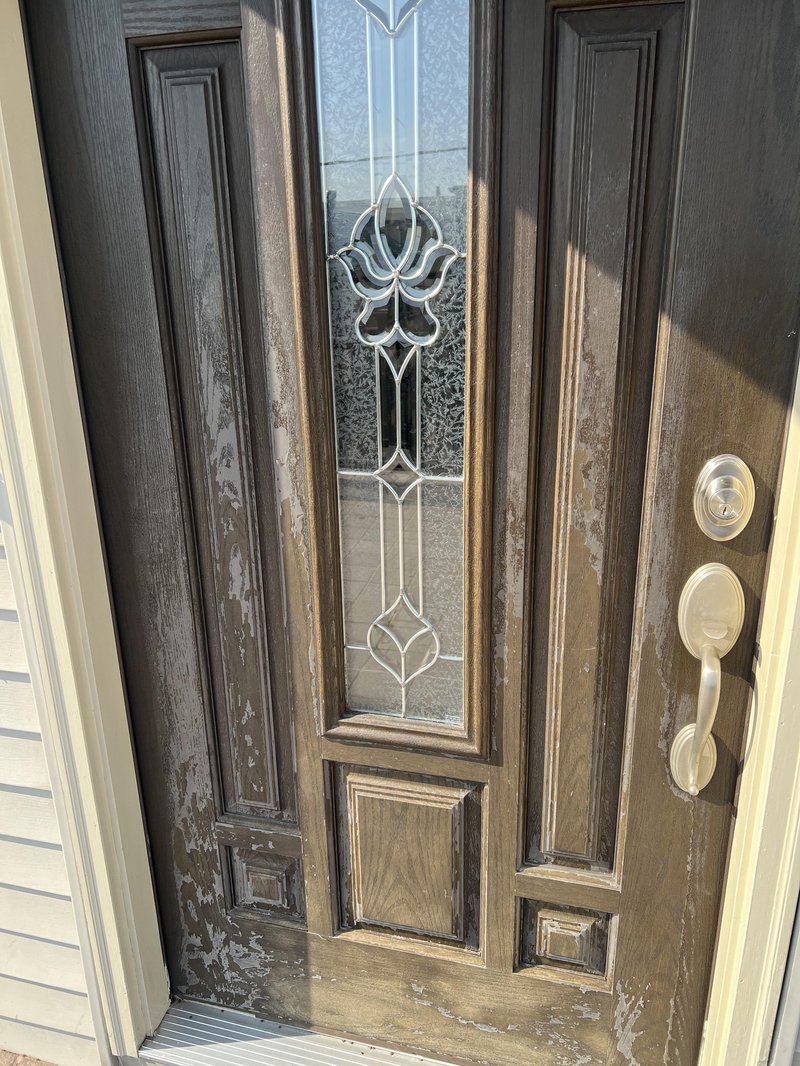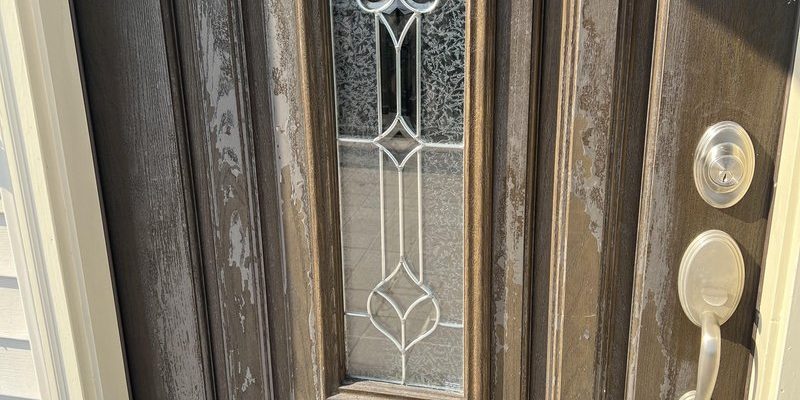
Here’s the thing: you might expect metal hardware to age gracefully like an old leather chair, but most of us end up with a Frankenstein look—some spots faded, others shiny, weird shadows where your thumb rests, or ghostly outlines from that long-gone sticker. It’s frustrating, especially if you picked out a fiberglass door for its low maintenance or splurged on a nice finish. Let’s dig into what really causes this uneven fading, why it happens more on fiberglass doors, and what you can actually do about it.
How Sunlight and Weather Affect Fiberglass Door Hardware
First, let’s talk about the biggest culprit: the sun. If your front door faces south or west, you’re getting hammered with UV rays day after day. And here’s a detail a lot of people miss: fiberglass doors don’t absorb heat the same way wood or steel doors do. Instead, they reflect light, which can bounce and focus rays onto your hardware in unpredictable ways. That’s why even high-end, “weatherproof” handles can start to fade unevenly—one area gets scorched, another stays in the shade.
But it’s not just sunlight. Rain, snow, salty air, and even pollen can coat or react with the finish on your hardware. Fiberglass doors sometimes collect moisture differently at the top, bottom, or edges, making the hardware wear out unevenly. Over time, that means spots under the eaves or in shadowy corners stay shiny, while the rest fades or peels.
If you live somewhere with big temperature swings—say, freezing in winter and blazing in summer—your hardware’s finish gets pushed and pulled as it expands and contracts. This stress, combined with moisture and sunlight, acts like a slow-motion sandblaster, breaking down the protective layer and causing that ugly, uneven look.
Why Fiberglass Doors Make Fading More Noticeable
You might be wondering, “Why does my neighbor’s wooden door hardware look fine, but mine is patchy?” The answer has a lot to do with how fiberglass doors interact with their hardware. Unlike wood or steel, fiberglass is non-porous and doesn’t “breathe” or change temperature much. It’s great for energy efficiency—but all that stability can actually make hardware finishes age faster in certain spots.
For example, fiberglass resists most weather, so water runs right off. But if you have a fancy multi-point locking system or tall handles, water can pool around screws and grooves, leaving behind mineral deposits or even pitting the metal. That’s how you end up with a faded circle around the lock, or a pale strip under a handle that’s protected when the door is closed.
Here’s another thing: darker fiberglass doors absorb and radiate heat differently compared to lighter ones. If your door is painted navy, espresso, or black, you might notice fading happening faster or in odd patterns on your hardware, especially near edges or where parts overlap.
Types of Hardware Finishes and Their Lifespan
Not all hardware is created equal, and the finish matters way more than you’d think. Brands like Schlage, Kwikset, and Emtek offer a buffet of hardware options—satin nickel, aged bronze, polished brass, matte black, you name it. Each one wears down in its own way:
- Satin finishes (like satin nickel) tend to show fingerprints and water spots, which can turn into permanent streaks over time as the topcoat wears away unevenly.
- Polished metals (like brass or chrome) look shiny at first, but any scratch, pit, or bit of corrosion stands out like a sore thumb, making fading look blotchy.
- Powder-coated or painted finishes promise extra durability, but once the coating cracks from a door slam or key scratch, moisture gets in and the fade spreads from that spot.
- Oil-rubbed bronze can fade into coppery or greenish tones, especially if exposed to acids (like pollen or bird droppings) or household cleaners.
Honestly, even the priciest finishes can fade weirdly if installed on a fiberglass door exposed to harsh weather. Most brands specify “lifetime” or “limited” warranties, but these often exclude fading from sunlight or weather as “normal wear and tear.”
User Habits That Speed Up Uneven Fading
Let me explain: sometimes, it’s not just the weather—it’s us. Oils from your fingers, bits of sunscreen, bug spray, or even that “miracle” cleaning spray can eat away at a hardware finish. If you always grab the knob the same way, you’ll see a thumbprint-shaped shine. If you scrub the area near the lock more than you buff the handle, you’ll get a brighter patch there.
A classic example: If you decorate for holidays, tape or suction cups over your hardware can create sharp lines between faded and protected areas. It might sound silly, but even wind chimes or door knockers brushing past the lock can wear down the finish in curved, unpredictable shapes.
Maybe you’re a little rough-handed or have kids who love slamming the door. That daily pounding, even if you don’t notice it, chips away at any protective coating—especially on a fiberglass door, since the material underneath doesn’t cushion the hardware as much as wood.
Chemical Reactions Unique to Fiberglass Door Hardware
Here’s a detail a lot of homeowners overlook: fiberglass doors and certain hardware finishes can actually trigger tiny chemical reactions. Most modern door hardware is made from a combination of brass, zinc, or steel, covered by a clear sealer or powder coating. But fiberglass doors are finished with resins and paints that might off-gas slowly over time, especially when heated by the sun.
That off-gassing can interact with the hardware’s coating, causing cloudiness, tackiness, or even odd discoloration. For instance, you might see a rainbow effect or “frosted” patches where the resin fumes have reacted with the hardware. Cleaning products like bleach or ammonia—which are a no-go for both fiberglass and hardware—can double down on this effect, breaking down the finish twice as fast.
If your weatherseal or door gasket uses a rubber or vinyl compound, that can also migrate onto the hardware during hot weather, causing stickiness or streaky fading. You won’t see it happen—just the odd, uneven fading left behind.
Comparing Hardware Fading: Fiberglass Doors vs. Other Materials
You might be thinking, “Would I have this problem with a wood or steel door?” Good question. Wood doors tend to expand, contract, and wick moisture, so hardware finishes may wear more evenly, just because the whole door is changing all the time. Steel doors, on the other hand, can rust—but their solid, constant temperature usually means fading happens slower and more uniformly.
With fiberglass, since the door itself doesn’t shift or swell much, all the environmental punishment gets focused right on the hardware. That’s why fading, peeling, or pitting seems to happen in streaks or spots, instead of a gentle patina across the whole thing.
If you swap your hardware onto a universal backplate or kickplate, you might notice the areas under the plate stay bright and shiny, while the exposed bits fade or turn dull. This is one reason some people switch to plastic or composite hardware on fiberglass doors, though those have their own pros and cons—mainly, they scratch easily and can discolor with age.
Preventing and Fixing Uneven Fading on Door Hardware
Now for the million-dollar question: how do you keep your fiberglass door hardware from fading unevenly—or fix it if it already has? Here are some real-world tips:
- Regular, gentle cleaning. Skip harsh chemicals—use mild soap and water, then dry completely. Avoid scrubbing with scouring pads, which can strip protective coatings.
- Apply a protective wax. Some brands recommend carnauba wax or a silicone-based sealer to repel moisture and slow UV damage. Test in an inconspicuous area first.
- Install a storm door or hardware cover. These can block the worst of the sun and rain, giving your hardware a fighting chance.
- Rotate your cleaning habits. Try not to focus all your scrubbing or disinfecting on just the lock or knob. Even wear helps avoid patches.
- Use touch-up kits. Many brands offer touch-up pens or sprays for common finishes. If discoloration is light, this can even things out.
- Replace with fade-resistant hardware. If all else fails, upgrade to marine-grade or “lifetime finish” hardware, but double-check the warranty fine print about fading and UV damage.
If your fading is already severe—think peeling, green spots, or white powdery areas—you may need to sand and refinish, or just swap out the hardware. Sometimes the damage is only skin-deep, but if the metal underneath is corroded or pitted, a replacement is usually best.
Honestly, even the most careful homeowner can’t stop nature and time forever. But small adjustments—like choosing the right wax, cleaning smart, or adding a bit of shade—can stretch out your hardware’s good looks for years.
When to Call a Pro (And When It’s Not Worth It)
You might wonder if it’s worth bringing in a locksmith or a door specialist to fix uneven hardware fading. Here’s my take: if your handle, keypad, or lock is still working fine—no sticking, no signs of rust or battery leaks—it’s usually safe to handle the cosmetic fixes yourself. But if your hardware is modern (like an electronic deadbolt or smart code lock) and fading comes with weird syncing issues, battery drains, or sticking buttons, it might signal a deeper problem with moisture or corrosion inside the mechanism.
Professional door techs can sometimes polish or re-coat high-end hardware, but for most brands, labor costs will outweigh the price of just swapping for new handles. The only time I’d really call in a pro? If your lock mechanism is jammed, the finish is bubbling up, or you see white crusty deposits—those could mean your hardware’s insides are corroding, not just the surface.
If you do replace your hardware, make sure to:
- Check compatibility with your fiberglass door’s thickness and prep holes.
- Sync up any smart features, remotes, or codes right after install—sometimes new batteries are needed after a replacement.
- Store your warranty info in case you see fading return.
A little bit of DIY goes a long way, but know when to call it quits if the job’s above your comfort zone.
Final Thoughts: Living with Hardware Fading on Fiberglass Doors
Uneven fading on fiberglass door hardware is one of those little things that can bug you every time you come home. Still, it doesn’t mean your door or locks are low-quality—just that nature is relentless, and fiberglass changes how your hardware ages. From the sun’s punishing rays and sneaky chemical reactions to your own cleaning habits, lots of tiny factors add up over time.
If you notice fading, don’t panic. Watch for bigger issues—like sticking locks, corroded keypads, or battery problems on smart remotes—and handle cosmetic fixes with patience and the right tools. With a little attention (and maybe a well-placed shade), your fiberglass door and hardware can keep looking sharp, minus the patchwork fade. And if all else fails, consider a quick swap for a finish better built for your climate—your door, and your eyes, will thank you.
